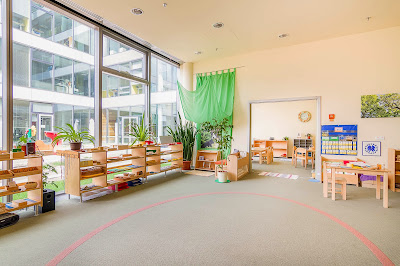Feng shui is a traditional Chinese art which deals with the relationship of man and his environment. It is based on the perception of the environment and its transformation towards the natural flow of energy. It is applicable to all kinds of environemt and a nursery can definitely be one of them.
Creation of harmonious space according to the principles of feng shui (literally "wind and water") requires a sensitivity to the whole and at the same time a great eye for detail and particulars. The key element is to be present in a given space, to physically dwell in it and observe. How do the children behave? Where they go slowly and where they tend to run? Are there places in the area which the children avoid or which prevent them from moving freely? Just watch and see. Another key factor in your observation should be the realization of the source and flow of energy. Where does the energy comes from? In NestLingue the source of energy, the imaginary energetic river, comes from the light of the Sun traveling across the sky and entering the huge windows in the class (on Southeast side). Additional gates of energy in the room are the doors. All this must be taken into account when you think about what role this or that area of the room plays in the overall energy exchange.
Energy behaves like water. It flows into the room from its source, passes through it and flows away from it. When you realize where does the "energy river " of the room flows, how it flows, where does it stop or where is it running at high speed, you can proceed to act. The goal of feng shui is the flow. Energy should not rush fast into the room and quickly fly away from it again. Nor does it have to create "dead river arms" of stagnant chi. Energy, like water, loves to meander and twist. It loves to divide and unite again.
I realized, for example, the window sill, through which the light and energy enters into Primary class was full of discarded things, tools, boxes, papers etc. Furthermore, the energy passed through the aquarium, which was often clogged and its back wall was covered with a ragged and worn piece of paper with a picture of underwater plants. The energy entered the class and travelled straight and fast into the center of the room to the ellipse, which is not only the central point of the room but also the centrum for the Montessori learning program as well. The impact of this setup was quite evident in the behavior of children, especially boys, who often displayed feelings of restlessness.
It was necessary to clean the window sill, ensuring good water filtration in the aquarium, and we also got rid of the glued paper. I changed the layout of the tables and shelves with Montessori tools so that the incoming energy flow slowed down and spread from the middle of the room to all its corners and kept flowing through these areas whilst it still continually headed towards the energetic center of the room – the ellipse. This way, the ellipse is provided with cultivated, rich energy which passes through the whole class and has the right properties and potency. It was also necessary to realize where the energy from ellipse flows further on and at what point it ends and flows away from the room.
Every object and every bit of space plays an important role in the overall settings. Proceed from large to small and from easy to fine and subtle things. Considering the complexity of the topic I cannot truly mention all that is important here that I take into consideration like the consistence and placement of colors, shapes or logical sequence of the functional part of classes, the pedagogical elements and nursery area as a whole.
I rebuilt the Toddler class according the same principles as well. And a lot of other changes preceeded this change in both classes. I decorated the hallway which changed into a gallery of photos of our children. We completely rebuilt and changed the office of teachers and also a room for preparation of food for children, the bedroom and last but not least also the office of the Head of school. These changes had significant direct and also indirect effect not only on the children but also on the staff and parents of the children.
One thing is to perceive the space and relationships, and make efforts to achieve harmony. The other thing is to keep the space harmonious and maintain its order. It requires to be constantly tuned and present, to perceive the passage of time with the connection to transformations of space and relationships that take place in it and to reflect it. The best and the most accurate mirror as to a level of harmony and quality of feng shui are the feelings and behavior of the children. They always perfectly show you when and where your awareness works properly and where you need to look into things again and make the neccessary adjustmens.










